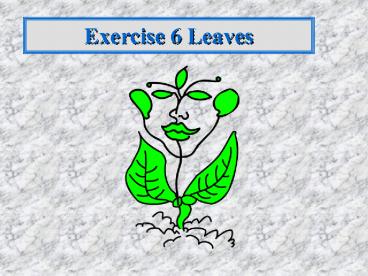Exercise 6 Leaves - PowerPoint PPT Presentation
1 / 39
Title: Exercise 6 Leaves
1
Exercise 6 Leaves
2
Introductory Notes
- (copy these notes on your exercise)
- Leaves are the major food making parts of plants
but they can be used for many other purposes. - Tree leaves come in a wide variety of shapes and
sizes and can be used to identify the tree.
3
Skip to page 56
- Internal Structure of Leaves
4
Internal Structure of LeavesDicot
- Highlight or underline 3 major tissue types
present epidermis (upper lower) mesophyll
veins. - Answer question 1.
5
Use this diagram to answer questions 2,3,45.
Chloroplasts
Photosynthesis
Air space
6
Answer question 6
Mid rib
Xylem
Phloem
7
Cuticle
U. Epidermis
Palisade Mesophyll
Stoma
Spongy Mesophyll
L. Epidermis
Air Space
Guard Cells
Figure 6.7
8
Internal StructureMonocot Leaf
- Highlight or underline
- The epidermis contains enlarged bulliform cells.
It is thought that these cells lose water more
rapidlycauses the leaf to curl during dry
conditions, possibly preventing excessive water
loss. - Answer question 7.
9
Bulliform cells
Bundle sheath extension
U. Epidermis
Mesophyll
L. Epidermis
Figure 6.8
Xylem
Phloem
10
Leaf Modifications
- Highlight or underline plants that grow in
neither dry or wet environments are mesophytes.
Plants that grow in arid conditions are
xerophytes, while plants that grow in water are
hydrophytes.
11
Xerophyte Features
- Highlight or underline the top of the leaf has
a very thick cuticle. - Larger cells comprise the hypodermis a water
storing tissue - Guard cells and stomata are located only on the
lower surface and are sunken in stomatal crypts
12
Figure 6.9
Cuticle
Upper Epidermis
Hypodermis
Palisade mesophyll
Spongy mesophyll
Stomatal Crypt
Lower Epidermis
13
Hydrophyte Features
- Highlight or underline stomata located only in
the upper epidermis. There is no cuticle and the
epidermal cells are thin walled. - Answer question 8
Air spaces
14
Figure 6.10
Upper epidermis
Palisade Mesophyll
Spongy Mesophyll
Air chambers
Astrosclereids
15
Nerium oleander
Answer questions 9 10
16
Leaf Abscission
- Highlight or underline
- most woody dicots in temperate regions produce
new leaves each spring and lose them in the fall.
Leaf fall is associated with the development of a
special layer called the abscission zone. - This layer has two layers. The separation layer
has parenchyma cells that are easily broken. - The cork layer protects against water loss when
the leaf falls off
17
Figure 6.12
Lateral bud
Leaf petiole
Separation layer
Cork layer of Abscission layer
Bundle scar (developing
Vein
Pith
18
Stop
- This concludes this portion Exercise 6
19
External Morphology of Leaves
- Highlight or underline
- Leaves of plants show considerable variation in
form, size, structure and arrangement on the
twig. - This leaf consists of a broad flat blade, a leaf
stalk or petiole, and a pair of small leaf like
structures stipules found at the base.
20
External Morphology of Leaves
- Highlight or underline
- A leaf having all three of these structures is
said to be complete. - If one or more is missing the leaf is incomplete.
21
Figure 6.1 Make a Diagram and Label
Blade
Petiole
Stipule
22
Leaf Venation
- Highlight or underline
- Monocots characteristically have a venation
pattern parallel to each other.
23
Figure 6.2 Monocot Leaf
Veins
24
Highlight or underline
- Dicots Have Netted Venation- two variations may
be found - Pinnate venation one main vein with lateral veins
branching from it - Palmate venation have several main veins from one
single point (like a hand)
25
Types of Leaves
- Highlight or underline
- Leaves may be categorized by the type of leaf
blade. A single leaf blade is simple, if it is
separated into several smaller units it is
compound. Each unit is a leaflet.
26
Types of Leaves
Types of Leaves
- Highlight or underline
- Palmately compound leaves have all leaflets
arising from a common point - Pinnately compound leaves have leaflets arising
at intervals along a main axis or rachis-an
extension of the petiole
27
Types of Leaves
- Look at the next slides sketch and label as
simple or compound and pinnate or palmate under
the sketch
28
Pinnate Veins
Pinnate Veins
Simple
Compound
Figure 6.3
Figure 6.4
29
Palmate Veins
Palmate Veins
Compound
Simple
Figure 6.6
Figure 6.5
30
Carnivorous Plants
Highlight or underline Among the most
interesting leaf adaptations are those of
carnivorous plants. These include the pitcher
plant and Venuss fly trap
Venuss Flytrap
Pitcher plant
31
Bladder
Highlight or underline A less known plant with
this adaptation is the bladderwort. Draw and
label 6.11
Bladderwort
Figure 6.11
Sensitive Hairs
32
Questions
- Answer questions on page 61
33
Leaflet no stipule or thick petiole base
34
Monocot no palisade layer
35
Xerophytes
- Very thick cuticle
- Thick epidermis
- Sunken stomata
36
Monocot/Dicot Roots
ClueNote location of vascular tissue and pith in
each
37
Monocot/Dicot Stems
ClueNote location of vascular tissue and pith in
each
38
Monocot/Dicot Leaves
39
The End
Created by R.E. Lynn































